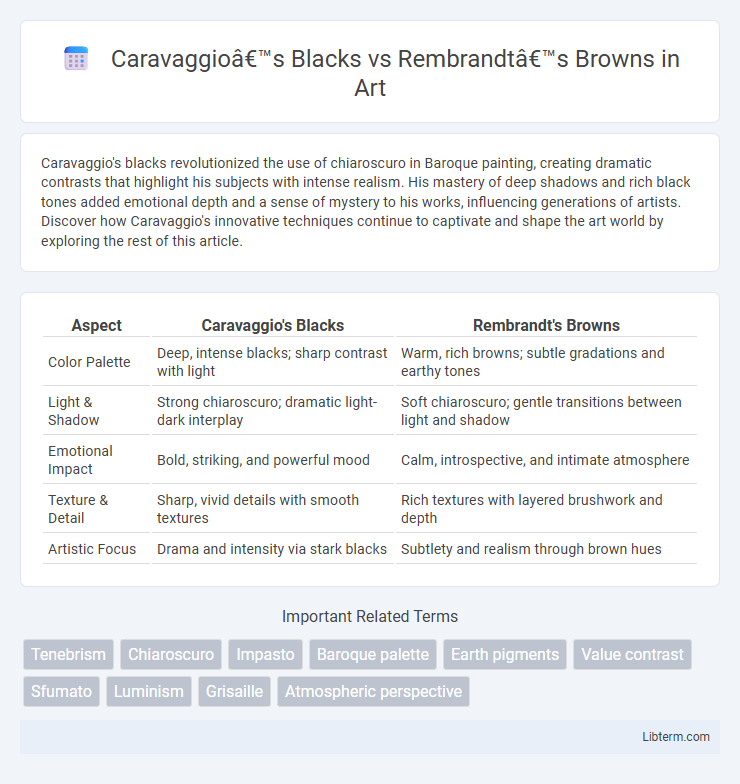Caravaggio's blacks revolutionized the use of chiaroscuro in Baroque painting, creating dramatic contrasts that highlight his subjects with intense realism. His mastery of deep shadows and rich black tones added emotional depth and a sense of mystery to his works, influencing generations of artists. Discover how Caravaggio's innovative techniques continue to captivate and shape the art world by exploring the rest of this article.
Table of Comparison
| Aspect | Caravaggio's Blacks | Rembrandt's Browns |
|---|---|---|
| Color Palette | Deep, intense blacks; sharp contrast with light | Warm, rich browns; subtle gradations and earthy tones |
| Light & Shadow | Strong chiaroscuro; dramatic light-dark interplay | Soft chiaroscuro; gentle transitions between light and shadow |
| Emotional Impact | Bold, striking, and powerful mood | Calm, introspective, and intimate atmosphere |
| Texture & Detail | Sharp, vivid details with smooth textures | Rich textures with layered brushwork and depth |
| Artistic Focus | Drama and intensity via stark blacks | Subtlety and realism through brown hues |
Introduction: The Masters of Chiaroscuro
Caravaggio's use of intense blacks creates stark contrasts that emphasize dramatic tension and highlight figures with striking clarity. Rembrandt's warm browns produce a softer interplay of light and shadow, lending his works a more intimate and textured atmosphere. Both artists master chiaroscuro to manipulate light and darkness, but their distinct palettes define the emotional tone and depth within their compositions.
Historical Context: Baroque Italy vs Dutch Golden Age
Caravaggio's use of deep blacks and stark chiaroscuro emerged in Baroque Italy, reflecting the dramatic tension and religious intensity of early 17th-century Catholic Counter-Reformation art, emphasizing spiritual realism and emotional immediacy. Rembrandt's earthy browns and warm ochres, characteristic of the Dutch Golden Age, convey a more intimate, personal approach to light and shadow, aligning with Protestant values and the rising middle-class patronage that favored realism and introspection. These contrasting palettes illustrate divergent cultural and theological influences shaping Baroque Italy's theatricality and the Dutch Republic's nuanced naturalism.
Caravaggio’s Palette: The Depth of Black
Caravaggio's palette is distinguished by the profound use of blacks, creating intense chiaroscuro contrasts that add dramatic depth and focus to his compositions. His mastery of black pigments, often achieved through layering and glazing techniques, enhances the three-dimensionality and emotional intensity of his figures. Unlike Rembrandt's warmer browns, Caravaggio's blacks serve as a powerful tool to emphasize realism and stark visual tension in his paintings.
Rembrandt’s Palette: The Warmth of Brown
Rembrandt's palette is renowned for its rich browns that create a warm, intimate atmosphere in his paintings, contrasting sharply with Caravaggio's dramatic use of deep blacks to evoke tension and mystery. The warm browns in Rembrandt's work, achieved through layered glazes and earth pigments like umber and sienna, enhance the realism and depth of his subjects, adding emotional resonance and subtle gradations of light. This mastery of brown tones allows Rembrandt to capture the nuances of human skin and fabric textures, contributing to the enduring impact of his portraits and biblical scenes.
Techniques in Shadow: Stylistic Distinctions
Caravaggio's approach to shadows emphasizes stark contrasts with deep, velvety blacks that create dramatic chiaroscuro effects, intensifying the emotional impact and three-dimensionality of his figures. Rembrandt employs a subtler palette of rich browns and warm shadows, using layered glazes and delicate gradations to achieve a softer, more lifelike rendering of textures and atmospheres. These stylistic distinctions highlight Caravaggio's theatrical immediacy versus Rembrandt's nuanced introspection, each mastering shadow to enhance narrative depth in Baroque painting.
Symbolism and Emotional Impact
Caravaggio's use of Blacks creates stark contrasts and dramatic symbolism, emphasizing themes of mortality and spiritual conflict through chiaroscuro and intense emotional expressions. Rembrandt's Browns evoke warmth and introspection, symbolizing human vulnerability and inner depth with softer transitions and nuanced facial details. Both artists harness color palettes to evoke profound emotional impact, yet Caravaggio's works confront viewers with raw immediacy while Rembrandt invites contemplative empathy.
Light Source and Composition Strategies
Caravaggio's use of stark chiaroscuro with a single, often unseen light source creates dramatic contrasts that isolate figures against dark backgrounds, emphasizing emotional intensity and physical presence. Rembrandt employs multiple, softer light sources that create warm, nuanced brown tones, fostering depth and a more naturalistic, intimate atmosphere through layered compositions. Both artists leverage light strategically, but Caravaggio's compositions highlight theatrical immediacy, while Rembrandt's evoke psychological complexity and subtle realism.
Influence on Contemporary Artists
Caravaggio's dramatic use of deep blacks established a powerful chiaroscuro technique that continues to influence contemporary artists seeking strong contrast and emotional intensity in their work. Rembrandt's mastery of warm browns and subtle tonal variations inspired modern painters to explore nuanced textures and naturalistic skin tones, enriching portraiture and narrative depth. Both artists' color palettes profoundly shape contemporary artistic practices by providing distinct approaches to light, shadow, and realism.
Restoration and Color Preservation Challenges
Caravaggio's use of deep blacks in his tenebrism technique poses significant challenges for restoration due to the pigment's tendency to darken and crack over time, complicating color preservation efforts. In contrast, Rembrandt's earthy browns, derived from layered glazes and natural pigments, require precise humidity and light control to maintain vibrancy without accelerating fading. Both artists demand specialized conservation strategies that address the chemical instability of their palettes while preserving the integrity of their original color schemes.
Legacy: How Blacks and Browns Shape Art History
Caravaggio's use of intense blacks creates dramatic chiaroscuro effects that revolutionized Baroque painting by emphasizing contrast and emotional depth, influencing countless artists in the shaping of visual storytelling. Rembrandt's nuanced browns provide warmth and subtlety, defining the Dutch Golden Age's introspective portraiture and mastery of light, fostering a legacy of realism and psychological complexity. Together, these distinct palettes forged foundational approaches to color and light that continue to inform modern art techniques and art historical discourse.
Caravaggio’s Blacks Infographic

 libterm.com
libterm.com